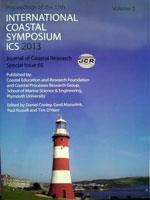Sottolichio, A., Hanquiez, V., Périnotto, H., Sabouraud, L. and Weber, O., 2013. Evaluation of the recent morphological evolution of the Gironde estuary through the use of some preliminary synthetic indicators. In: Conley, D.C., Masselink, G., Russell, P.E. and O'Hare, T.J. (eds.)
Drastic evolution of the physical coastal environment are expected in the future under the effect of climate change. They make necessary to better understand the past morphology evolution, especially considering areas that are the habitat for some specific ecosystems. Moreover, because the context of the water framework directive (WFD), EU members need to generate indicators to evaluate the status of estuarine water masses. To satisfy these two obectives, the recent evolution of the Gironde estuary has been studied by the analysis of bathymetry with GIS. The Gironde is the largest estuary of western Europe, and one of the most turbid. In this study, the analysis extents from 1962 to 1994. Results show that the zone of maximum volume of deposited sediment has migrated continuously towards the upstream portion of the estuary, which is coherent with the decrease of summer river flow and the upstream shift of the turbidity maximum toward the riverine sections. In addition, zones with relative stable and unstable morphology were identified, showing rythmic distribution similarly to those previously recognized through the evolution over 160 years (1825-1984). This seems to be independent from the fluvial regime, but rather related to the interaction between tidal cooscillations and estuarine morphology, which is not elucidated yet. Finally, some hydro-morpho-sediemntary (HMS) indicators useful to the WFD have been described : distribution of depths, changes on cross section areas, changes of intertidal areas. They are discussed to discriminate the “natural” and “anthropogenic” contribution to morphological changes observed.





